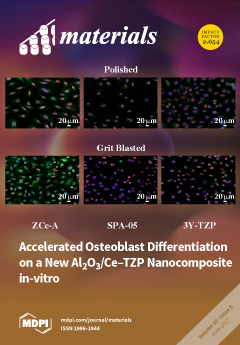A novel orange cationic iridium(III) complex [(TPTA)
2Ir(dPPOA)]PF
6 (TPTA: 3,4,5-triphenyl-4
H-1,2,4-triazole, dPPOA: N,N-diphenyl-4-(5-(pyridin-2-yl)-1,3,4-oxadiazol-2-yl)aniline) was synthesized and used as a phosphor in light-emitting diodes (LEDs). [(TPTA)
2Ir(dPPOA)]PF
6 has high thermal stability with a decomposition temperature (
Td)
[...] Read more.
A novel orange cationic iridium(III) complex [(TPTA)
2Ir(dPPOA)]PF
6 (TPTA: 3,4,5-triphenyl-4
H-1,2,4-triazole, dPPOA: N,N-diphenyl-4-(5-(pyridin-2-yl)-1,3,4-oxadiazol-2-yl)aniline) was synthesized and used as a phosphor in light-emitting diodes (LEDs). [(TPTA)
2Ir(dPPOA)]PF
6 has high thermal stability with a decomposition temperature (
Td) of 375 °C, and its relative emission intensity at 100 °C is 88.8% of that at 25°C. When only [(TPTA)
2Ir(dPPOA)]PF
6 was used as a phosphor at 6.0 wt % in silicone and excited by a blue GaN (GaN: gallium nitride) chip (450 nm), an orange LED was obtained. A white LED fabricated by a blue GaN chip (450 nm) and only yellow phosphor Y
3Al
5O
12:Ce
3+ (YAG:Ce) (1.0 wt % in silicone) emitted cold white light, its CIE (CIE:
Commission International de I’Eclairage) value was (0.32, 0.33), color rendering index (CRI) was 72.2, correlated color temperature (CCT) was 6877 K, and luminous efficiency (
ηL) was 128.5 lm∙W
−1. Such a cold white LED became a neutral white LED when [(TPTA)
2Ir(dPPOA)]PF
6 was added at 0.5 wt %; its corresponding CIE value was (0.35, 0.33), CRI was 78.4, CCT was 4896 K, and
ηL was 85.2 lm∙W
−1. It further became a warm white LED when [(TPTA)
2Ir(dPPOA)]PF
6 was added at 1.0 wt %; its corresponding CIE value was (0.39, 0.36), CRI was 80.2, CCT was 3473 K, and
ηL was 46.1 lm∙W
−1. The results show that [(TPTA)
2Ir(dPPOA)]PF
6 is a promising phosphor candidate for fabricating warm white LEDs.
Full article






